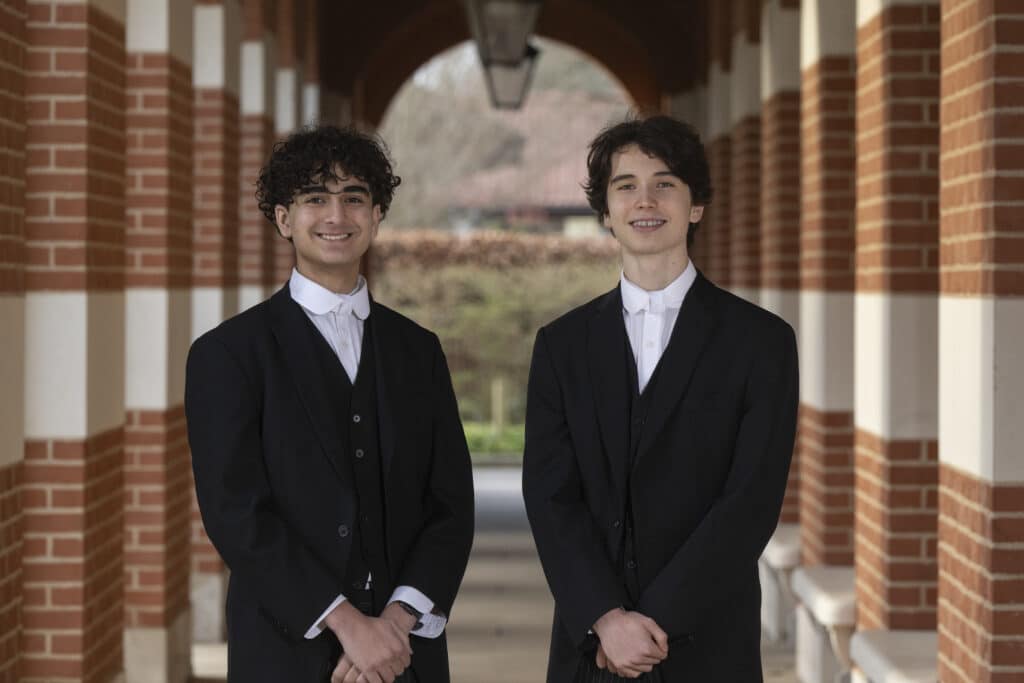At Eton College we are exploring the various ways AI can enhance teaching and learning in a safe and ethical way. We have called this endeavour the CAITLIN Initiative (Conversational Artificial Intelligence for Teaching & Learning: Integration & Normalisation). Its aim is to prepare our boys and students at our partner schools for a future where AI tools are as prolific and commonplace as the internet and smartphones are today.
The name Caitlin in the story below was chosen to mirror our CAITLIN Initiative.
A Typical School Day in 2028?
Caitlin wakes up one sunny morning and starts getting ready for school. It’s the year 2028 and Caitlin is 15 years old. She attends a secondary school in the UK and, in contrast to the experiences of her older brother, five years her senior, AI (Artificial Intelligence) tools form part of almost every lesson and subject. These changes have rolled out across all levels of education, including state and independent sectors. So undeniably crucial are AI skills to the world of business and industry that technology companies and governments have taken unprecedented steps over the last few years to make sure these AI tools are available to all schools.
Her first lesson is physics and today they are learning about gravity. To start the lesson, their teacher invites everyone to chat with Isaac Newton via their tablets and ask him what people used to think about gravity when he was young. The students in the class all start to speak to their tablets and a simulacrum of Isaac Newton on their screens responds to their questions. As the lesson progresses, simulacra of Einstein and Hawking are introduced. The teacher has set some objectives for the lesson in the form of 10 open questions. The AIs are all aware of these questions (the teacher having prompted them before the lesson) and have been instructed not to directly answer them, but rather guide the students to piece together the answers themselves.
Caitlin then moves on to history where she is preparing for a debate on the legacy of the British Empire; some project-based learning that the history teacher has set this week for the students to work on independently. Caitlin asks her AI to show her all her classwork, homework and lesson resources that mention the British Empire. Caitlin then asks her AI to extract all the countries that are mentioned in her notes and create a presentation with a slide for each country. She then proceeds to look at each of the countries to see what life was like before and after British colonisation, generating abridged timelines for the relevant major events in each country. To add some visual flare to her presentation, she asks her AI to generate some images of some key locations. All student AIs are equipped with generative AI plugins for image, speech, music, and code synthesis.
Just before lunchtime, Caitlin has an art lesson—her favourite subject! The students are halfway through a boardgame project where they have been challenged with designing and creating their own boardgames in groups of three. A couple of weeks ago, the group had brainstormed ideas verbally, which their AIs had transcribed and summarised. Last lesson, Caitlin used some plasticine to sculpt the pieces for her group’s Alice in Wonderland variant of chess. At the end of the last lesson, she had just finished 3D scanning them with her tablet ready to 3D print them at a reduced size, perfect for the boardgame. She asks her AI to open the files, add appropriate scaffolding and struts, and then send them to 3D printer no. 4, which currently has no print queue. The dual-filament printer says it will take six minutes to print the first piece in black and white; she can’t wait to paint them and starts mixing up some colours!
Later that day, Caitlin has a maths lesson. Her AI generates questions for her on the techniques she has found most difficult so far this year. When Caitlin gets a question right, her AI congratulates her. When she struggles, the AI talks her through worked examples of similar questions, step by step. Just as was the case in Caitlin’s physics lesson, the AIs don’t answer questions directly, but instead guide the students to develop the required skills themselves through example and scaffolded processes.
Meanwhile, Caitlin’s maths teacher has a dashboard on her tablet summarising what her students are working on. This allows her to play a crucial high-level role engaging in vital human contact, walking round the room giving encouragement and steering the AIs to focus on topics via the dashboard. The teacher can reallocate curriculum time according to what the students in the class most need to focus on as well as intercede if the students get frustrated or the AI’s lack of human context becomes an obstacle.
Her final lesson of the day is AI studies, a new subject introduced only a couple of years ago at Caitlin’s school. In the first year of the course, the students all developed a base level of AI literacy, recognised by most schools to be just as essential as literacy and numeracy. This inaugural year introduced the fundamentals of machine learning: neural networks, large language models, safe use of AI assistants, awareness of fake news and deep fakes, and much more. Recently, Caitlin was intrigued to discover that her primary school aged cousin was being introduced to prompt engineering, an idea that Caitlin herself had only been introduced to at secondary school. She can only begin to imagine what young people will be studying in five years’ time!
The topic today in AI studies is ‘bias and alignment’, which builds on their previous lesson’s research into the algorithms used in the early to mid-2010s for predicting risks of reoffending. Those algorithms, used in US courts, predicted much higher rates of reoffending for black defendants when compared to white; predictions which were proven to be unreliable in the years that followed, as brought to light by journalists like Julia Angwin. Today, the class is studying how the face recognition algorithms of the same era were also deeply flawed, being over a hundred times more accurate at recognising light-skinned males compared to dark-skinned females. They look at the work of Joy Buolamwini and others, who highlighted the problem, and who paved the way for more equitable AIs. Caitlin particularly enjoys the practical activity, trying out different face recognition algorithms on her fellow students via her tablet.
Caitlin then heads off to her after school netball training session. More often than not throughout her school life, the support of AI has a positive effect on collaboration and teamwork; however, it is still important to make time for tech-free social interactions and exercise!
That evening, Caitlin asks her AI what homework has been set and which is due soonest. The AI informs her that she needs to focus on biology consolidation tonight, reminding her that she has an ARA (Augmented Reality Assessment) tomorrow. During this, she will be asked to reassemble the parts of the digestive system and correctly identify the roles of each component. ARAs involve mounting her tablet on an elevated stand, then reaching her hands around the back of the device into the camera’s field of view to manipulate a simulated scene with her hands. She did well on her water cycle ARA last month so she is feeling pretty confident and starts running through some practice activities recommended to her by her AI.
I hope you have found this story to be thought provoking. Only time will tell how accurate a prediction it is!



